Sightseeing in Athens – the highlights
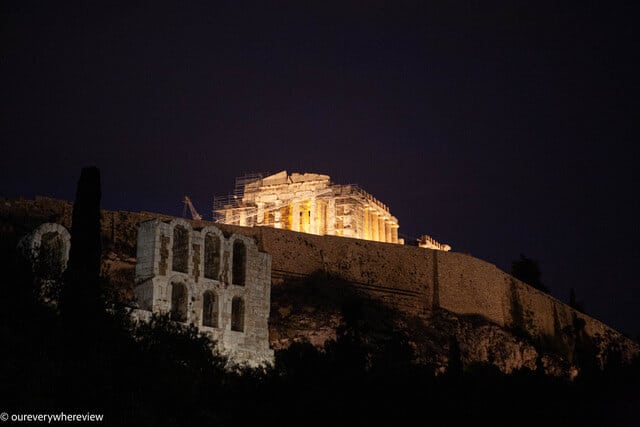
There is a lot of anticipation around visiting Athens. Athens *is* Ancient Greece, the cradle of western civilization. Athens is thousands of years of history and innumerable volumes of mythology. Athens is a record in stone of one powerful civilization after another. It is hard to see Greece without seeing Athens.
Athens is a city you need to visit at least once (if you love history, more than once). But for all it is overwhelming in history, it’s rather underwhelming in flavour. The city is a sprawling metropolis. The main sights of interests are embedded in a sea of urban explosion. (The city did not have much in the way of urban planning until the 2004 Olympics.) What is REALLY interesting, however, is just how embedded the history is. You can be walking along the road between your bus stop and your hotel, and chance upon some small Roman or Greek ruin. Even so, add in the political and economic turmoil in recent years, Athens is really a city that lends itself more to focused sightseeing, than wandering or lingering.

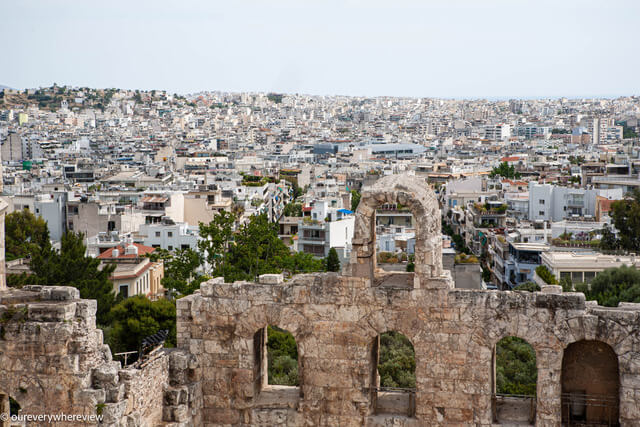
In our 14 day Greece itinerary, we recommended seeing Athens in two days. Two days is enough to hit the highlights, with just the right amount of meandering and easy strolling in between. We recommend booking a hotel or renting an airbnb around Acropolis hill. This will be walking distance to most of the must-visit sights. The main tourist area around Acropolis hill also offers a mix of expensive restaurants and tasty hole-in-the-wall joints serving traditional Greek fare.
The must-hit sights include: Acropolis (+/- museum), the Agora, the National Archaeological Museum.
Acropolis
The Acropolis is one of the most famous ancient sites in the world, and a UNSECO heritage site. The term “acropolis” means “high city”. It is an imposing rocky outcrop, and even now, the very heart of the city. In its time, the Acropolis has been a temple, a fortress, the palace of kings.
The most famous structures (Parthenon) were constructed in the fifth century BC, after the Athenians drove off the invading Persians. The complex was dedicated to Athena, the Goddess of victory. During Greece’s golden age (4th century AD), the entire complex underwent a major overhaul. Many of these structures were decimated as Athens endured invasion after invasion in subsequent centuries. Major reconstruction has been underway since the 1970s.
If visiting in the warmer months, it’s best to visit the Acropolis in the late afternoon. Athens averages 31-32 degrees C in the summer, and there is no shade to be found on the Acropolis. Even when we visited in May, in the late afternoon, it was still *hot* (stray dog napping under trees all up the pedestrian walkway).
You *need* a guide
Exploring the Acropolis is best done as a guided tour. Or, a self-guided tour with the help of a map, guidebook, or app. You can read and learn as much as you can beforehand, but when you get there, all the ruins start to look the same.
We had a Rick Steves guidebook, and used his walking tour (which was great). Lately (ever since a GPS guided audio-tour on our Hawaii trip), I’ve been really into GPS/phone guided tours. There are apps for your phone (eg. GPSMYCITY) or audio tours you can download (eg. cliomusetours). You can also book a 1.5-2 hour guided tour (eg. Skip the Line Acropolis Tour), that will cost around 50-90 CAD. What you need is someone or something that will explain to you what each ruin is, and the story behind it.
The Parthenon: our thoughts
The Parthenon is undoubtedly the “piece de resistance” of the lot. To see it in person was actually… a little underwhelming. The entire building was destroyed in the 1600s after a Venetian bomb hit it while it was under Turkish rule. It was, at the time, being used as a storage facility for gunpowder. When we saw it, the front half of it was covered by scaffolding (as part of the reconstruction), and the sides missing (not yet reconstructed).
It’s one of those sights better furnished by the imagination. The sheer size of it makes the translation to camera even worse. However, having first learned about the construction of the Parthenon in maybe the 6th grade, the illusions employed by architects of the time to make the building look aesthetically pleasing to the eye are mind-blowing (ie. making the middle higher, the end columns closer together, the columns tapered).
The view
Stop for a one-of-a-kind view of Athens from the Acropolis. The entire city is at your feet.
The Acropolis museum
This museum at the Acropolis is dedicated to archeological treasures found on the Acropolis We skipped this particular site (we did the National Archaeological Museum, instead), but it can easily be combined while visiting the site itself.
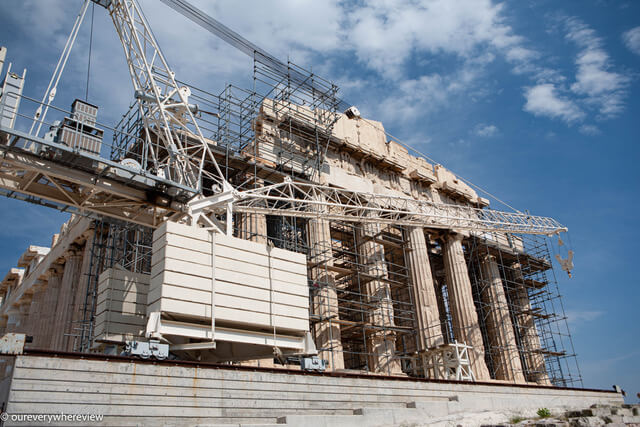
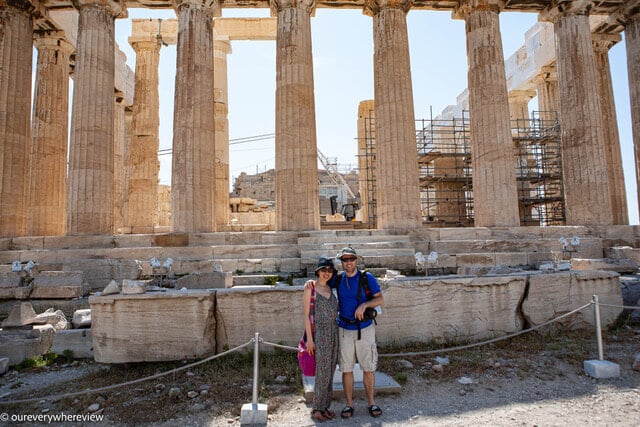
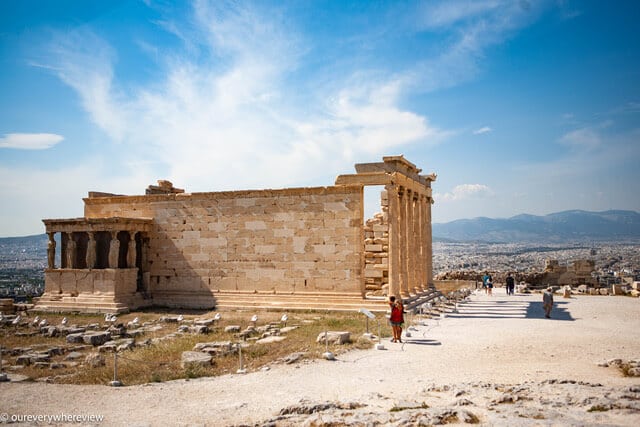
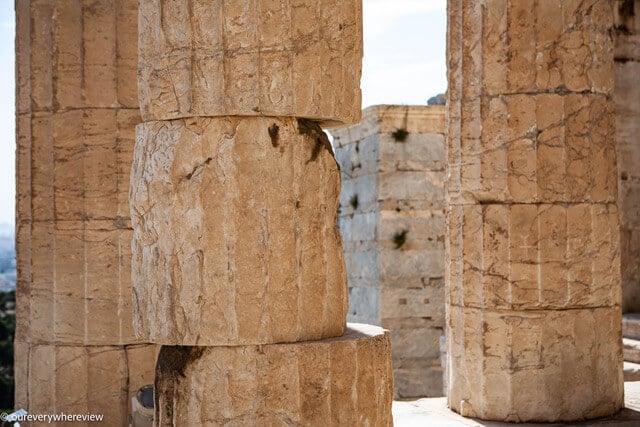

The Agora of Athens
The Agora, roughly translated into the modern “marketplace”, was the main gathering place for Ancient Greeks. It is basically the ruins of what used to be the hopping Athens downtown, where anyone who was anyone in Greece (including Socrates and Plato) spent most of their time. It is located beneath the Acropolis and within easy walking distance of the hill.
We wanted to visit the Agora early in the morning to avoid the midday heat. Unfortunately, the opening/closing times was not what we’d read they were, and that day it happened only to be open in the PM.
The Agora is another site best furnished by a vivid imagination. There’s a giant reconstruction of what used to be the marketplace. Most of the other sights are only marked by signposts. There are impressions of buildings, and columns here and there. There is also a remarkably well-preserved Classic era temple, the Hephaisteion, which is what I imagine the Parthenon *should* have looked like, on a smaller scale.
The most interesting part for me with the Tholos. It is a circular impression that marks where the Council of the Citizens (elected members of Athens) would meet – the birthplace of democracy.
You can certainly also download a tour – some Apps will include the Agora as part of their Athens or Acropolis walking tours. However, I feel the best way to experience the Agora is to wander your way through. It’s like exploring a city for the first time. Maybe somewhere along the way, I stood on the exact spot as Socrates once did?!
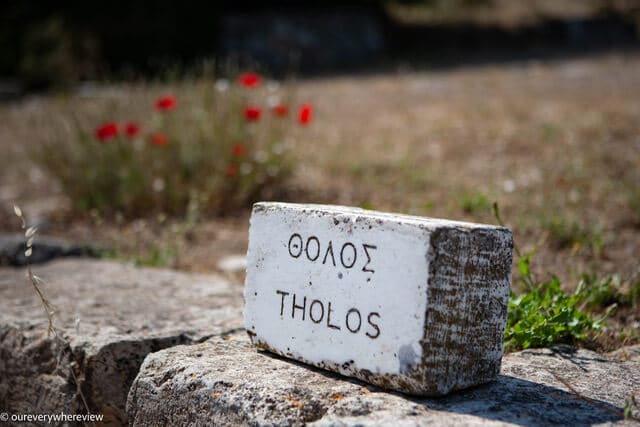
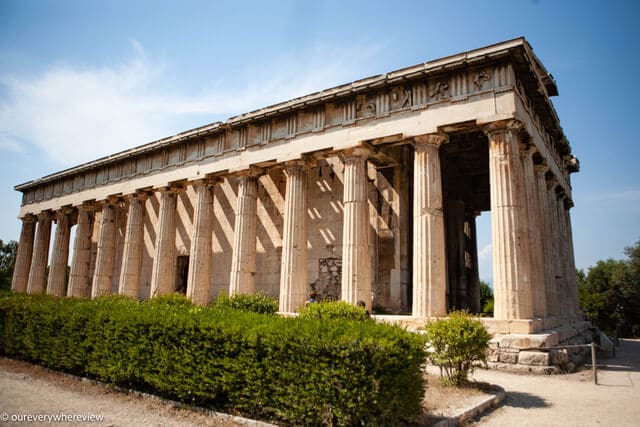
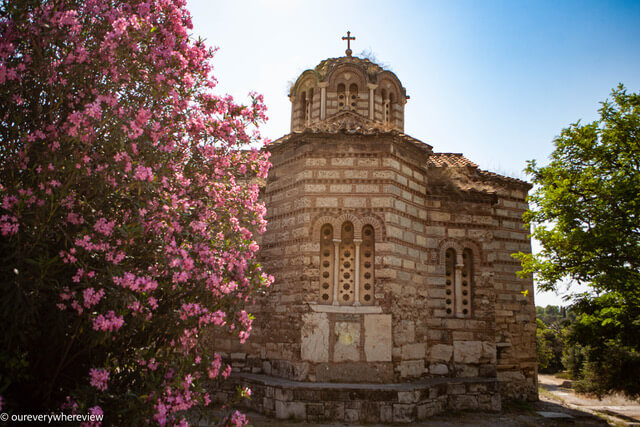
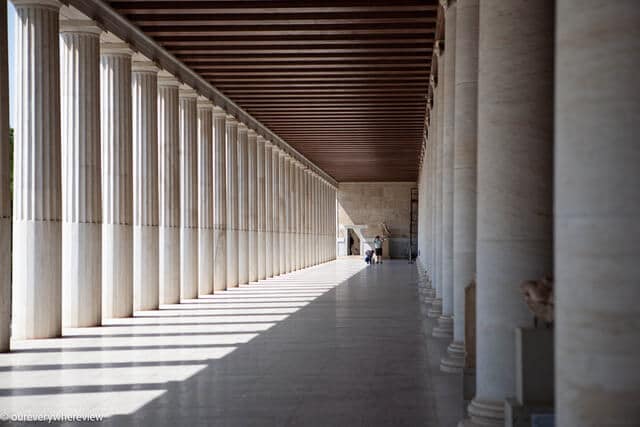
The National Archaeological Museum
The National Archeological museum takes you through the history of Greece; from prehistoric Minoans and Mycenaeans (of the famed Trojan fables), to classical Greece, to Roman Greece. It is the only major attraction that isn’t in the downtown core. We took a taxi on our way there, and a bus on our way back. Both were convenient.
Both Daniel and I have only a surface interest in archeology (once you’ve seen one ancient vase you’ve seen them all 😛 I’m kidding! Sort of…) We used the Rick Steves tour from his guidebook again, and went on a scavenger hunt of interesting displays to see. The museum is beautiful. There are a number of incredible sculptures and art, and artifacts with interesting backstories. (Eg. The Gold Mask of Agamemnon, the fabled King of Mycenae during the Helen of Troy years.)
Easy strolling
It’s always nice to take a walk whichever destination you go. Simply to admire the scenery and enjoy the vibe, without feeling like you need to tick items off a checklist. We took a hike to Mars Hill, spent an evening along the pedestrian walkways at the base of Acropolis hill, and had a gander through Plaka.
Mars Hill
This is an easy little climb. It’s adjacent to Acropolis hill, and offers the best vantage points of the Acropolis. We arrived just after sunset and enjoyed the cool evening breeze. (We also discovered the locale happens to be a haven for young couples making out.) The Acropolis was beautifully floodlit and serene at night.
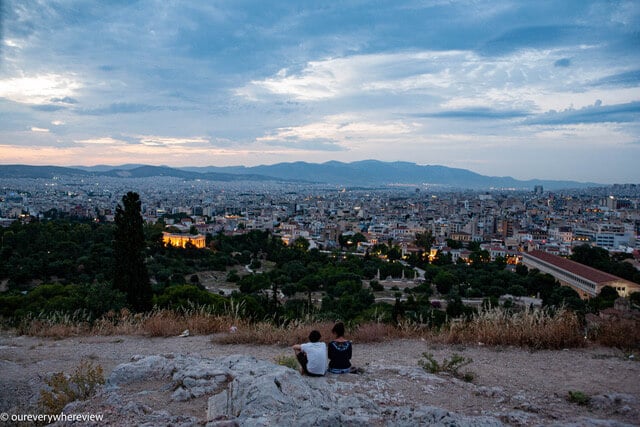
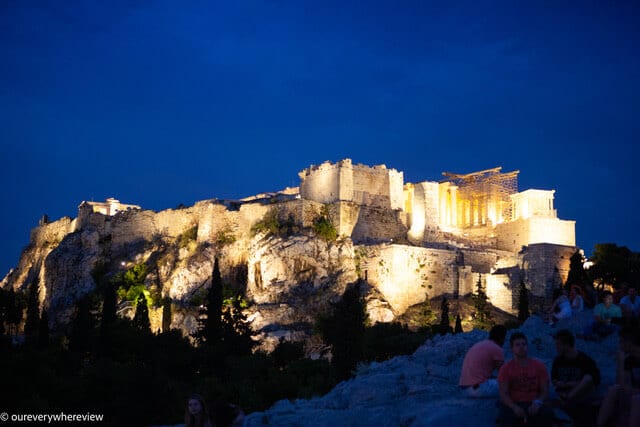
Dionysiou Areopagitou Pedestrian Street
This is a wide path located just below the Acropolis, popular with locals and tourists alike. During the day, it’s a quiet, sleepy place. At night, it comes alive with street musicians and performers, street vendors and food stands. Enjoying an authentic frozen Greek yogurt while being serenaded by a street violist or a Karaoke sounding warbling of a middle aged Greek woman is a great way to unwind after a busy day’s sightseeing.
Plaka
The Plaka is an old neighbourhood just below the Acropolis (between the hill and the Agora). It’s a quaint area with winding streets and neoclassical houses, cobblestone pathways, and vines that canopy overhead. It is a major tourist hub. There are restaurants and shops selling expensive jewelry and tourist trinkets and everything in between. I would say due to location, the food here is a little more expensive. The area is fun to explore, but if you are actually looking to buy something, you had better be prepared to haggle, and haggle hard.
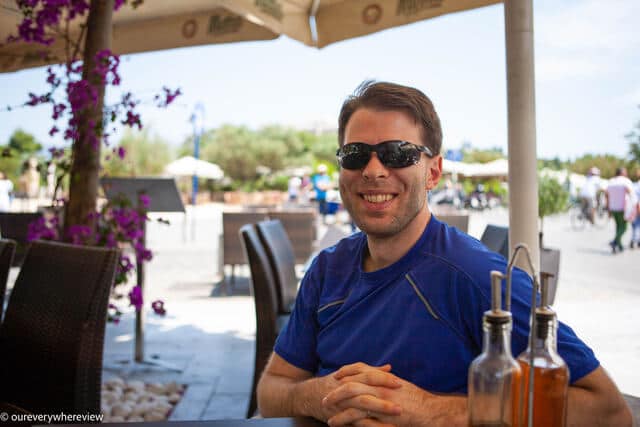
Bonus: recommended hole-in-the-wall eatery
We have never been white-linen tablecloths kind of travellers – most of the time we can hardly be bothered to make reservation. We prefer cafes, or small restaurants serving tasty local menus. The area around the Acropolis caters to all kinds of gastronomical preferences. Classy restaurants, hole-in-the-wall joints, little shops selling souvlaki…
Our airbnb hosts recommended To Kati Allo, which is south of the Acropolis and just happens to be a street away from our airbnb. (Also highly rated on many travel websites and Tripadvisor.) It’s a tiny tavern/patio space in a residential neighbourhood serving quintessential local fare – and man, was it ever tasty. It was the perfect kind of place for us – low-key, enjoying stuff tomatoes on rickety patio tables. We enjoyed it so much we went back twice!
Want to chat about Athens? Let us know what you think!
Interested in reading more about Greece?
Two weeks in Greece: itinerary
Nafplio and the Greek Peloponnese
Attraction spotlight: Ancient Olympia
Attraction spotlight: Delphi




Two weeks in Greece - Itinerary - our everywhere view
[…] You can read our entry about the sights in Athens here. […]
The charming town of Nafplio and the Greek Peloponnese - our everywhere view
[…] Sightseeing in Athens – the highlights […]
Attraction spotlight: Ancient Olympia - our everywhere view
[…] Sightseeing in Athens: the highlights […]